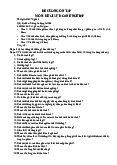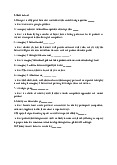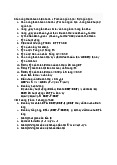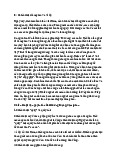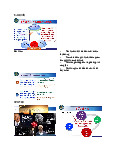





Preview text:
QUẢN TRỊ CHIẾN LƯỢC
1. Which of the following is not one of the five generic types of competitive strategy?
A. Focused low-cost provider strategy
B. Broad differentiation strategy
C. Overall low-cost provider strategy
D. Focused differentiation strategy
E. Market share dominator strategy.
2. The generic types of competitive strategies include
A. build market share, maintain market share, and slowly surrender market share.
B. offensive strategies and defensive strategies.
C. low-cost provider, broad differentiation, focused low-cost, focused differentiation, and best-cost provider strategies.
D. low-cost/low-price strategies, high-quality/high-price strategies, medium-quality/medium-price
strategies, low-cost/high-price strategies.
E. price leader strategies, price follower strategies, technology leader strategies, first-mover
strategies, offensive strategies, and defensive strategies.
3. A company’s competitive strategy deals with
A. management’s game plan for securing a competitive advantage relative to rivals.
B. what its strategy will be in such functional areas as R&D, production, sales and marketing,
distribution, finance and accounting, and so on.
C. its efforts to change its position on the industry’s strategic group map.
D. its plans for entering into strategic alliances, utilizing mergers or acquisitions to strengthen its
market position, outsourcing some in-house activities to outside specialists, and integrating forward or backward. E. All of these
4. A low-cost leader’s basis for competitive advantage is
A. lower prices than rival firms.
B. using a low-cost/low-price approach to gain the biggest market share. C. high buyer switching costs.
D. lower overall costs than competitors.
5. A competitive strategy of striving to be the low-cost provider is particularly attractive when
A. buyers are not price sensitive.
B. the industry is made up of a large number or equal-sized rivals.
C. there are many ways to achieve product differentiation that have value to buyers.
D. price competition is especially vigorous, buyers have low switching costs, and the majority of
industry sales are made to a few, large volume buyers.
E. switching costs are high, price competition is strong, and buyers tend to use the industry’s
products in many different ways.
6. To succeed with a low-cost provider strategy, company managers have to
A. pursue backward or forward integration to detour suppliers or buyers with considerable bargaining power and leverage.
B. move the performance of most all value chain activities to low-wage countries.
C. sell direct to users of their product or service and eliminate use of wholesale and retail intermediaries. D. do two things:
(1) perform value chain activities more cost-effectively than rivals and
(2) be proactive in revamping the firm’s overall value chain to eliminate or bypass
“nonessential” cost-producing activities.
E. outsource the majority of value chain activities.
7. Successful differentiation allows a firm to
A. command the largest market share in the industry.
B. set the industry ceiling on price.
C. avoid being overly concerned about whether entry barriers into the industry are high or low.
D. command a premium price for its product and/or increase unit sales and/or gain buyer loyalty to its brand.
E. take sales and market share away from rivals by undercutting them on price.
8. Perceived value and signaling value are often an important part of a successful
differentiation strategy when
A. the nature of differentiation is hard to quantify.
B. buyers are making a first-time purchase.
C. repurchase of the product or service is infrequent.
D. buyers are unsophisticated and unfamiliar with the capabilities of competing brands. E. All of these
9. Broad differentiation strategies generally work best in market circumstances where:
A. buyer needs and preferences are too diverse to be fully satisfied by a standardized product.
B. most buyers have similar needs and use the product in the same ways.
C. the products of rivals are weakly differentiated and most competitors are resorting to clever
advertising to try to set their product offerings apart.
D. buyers are price sensitive and buying switching costs are quite low.
E. the five competitive forces are strong.
10. What sets focused (or market niche) strategies apart from low-cost leadership and broad
differentiation strategies is
A. the extra attention paid to top-notch product performance and product quality.
B. their concentrated attention on a narrow piece of the overall market.
C. greater opportunity for competitive advantage.
D. their suitability for market situations where most industry rivals have weakly differentiated products.
E. their objective of delivering more value for the money.
11. A focused low-cost strategy seeks to achieve competitive advantage by
A. outmatching competitors in offering niche members an absolute rock-bottom price.
B. delivering more value for the money than other competitors.
C. performing the primary value chain activities at a lower cost per unit than can the industry’s low- cost leaders.
D. dominating more market niches in the industry via a lower cost and a lower price than any other rival.
E. serving buyers in the target market niche at a lower cost and lower price than rivals.
12. A focused differentiation strategy aims at securing competitive advantage
A. by providing niche members with a top-of-the-line product at a premium price.
B. by catering to buyers looking for an upscale product at an attractively low price.
C. with a product or service offering carefully designed to appeal to the unique preferences and
needs of a narrow, well-defined group of buyers.
D. by developing product attributes that no other company in the industry has.
E. by convincing affluent buyers that the company has a true world-class product.
13. A firm pursuing a best-cost provider strategy
A. seeks to be the low-cost provider in the largest and fastest-growing (or best) market segment.
B. tries to have the best cost (as compared to rivals) for each activity in the industry’s value chain.
C. tries to outcompete a low-cost provider by attracting buyers on the basis of charging the best price.
D. seeks to deliver superior value to buyers by satisfying their expectations on key
quality/service/features/ performance attributes and beating their expectations on price (given
what rivals are charging for much the same attributes).
E. seeks to achieve the best costs by using the best operating practices and incorporating the best features and attributes.
14. The aim of the best-cost provider strategy is to create a competitive advantage by
A. incorporating attractive or upscale product attributes at a lower cost than rivals
B. offering buyers the industry’s best-performing product at the best cost and best (lowest) price in the industry.
C. attracting buyers on the basis of having the industry’s overall best-performing product at a price
that is slightly below the industry-average price.
D. outcompeting rivals using low-cost provider strategies.
E. translating its best-cost status into achieving the highest profit margins of any firm in the industry.
15. For a best-cost provider strategy to be successful, a company must have
A. excellent marketing and sales skills in convincing buyers to pay a premium price for the
attributes/ features incorporated in its product.
B. the capability to incorporate upscale attributes at lower costs than rivals whose products have similar upscale attributes.
C. access to greater learning/experience curve effects and scale economies than rivals.
D. one of the best-known and most respected brand names in the industry.
E. a short, low-cost value chain.
16. Which of the following is not one of the strategy options for expanding into markets of foreign countries? A. A profit sanctuary strategy B. An export strategy C. A licensing strategy
D. Establish a subsidiary in a foreign market strategy E. A franchising strategy
17. The advantages of using an export strategy to build a customer base in foreign markets include
A. being able to minimize shipping costs, avoid tariffs, and curb the effects of fluctuating exchange rates.
B. minimizing capital requirements and involvement in foreign markets.
C. being cheaper and more cost effective than licensing and franchising.
D. being cheaper and more cost effective than a multi-country strategy.
E. facilitating the establishment of profit sanctuaries in foreign countries and being more suited to
accommodating local buyer tastes than a global strategy.
18. The advantages of using a licensing strategy to participate in foreign markets include
A. being especially well suited to the use of cross-market subsidization.
B. being able to charge lower prices than rivals.
C. enabling a company to achieve competitive advantage quickly and easily.
D. being able to leverage the company’s technical know-how or patents without committing
significant additional resources to markets that are unfamiliar, politically volatile, economically uncertain, or otherwise risky.
E. being able to achieve higher product quality and better product performance than with an export strategy.
